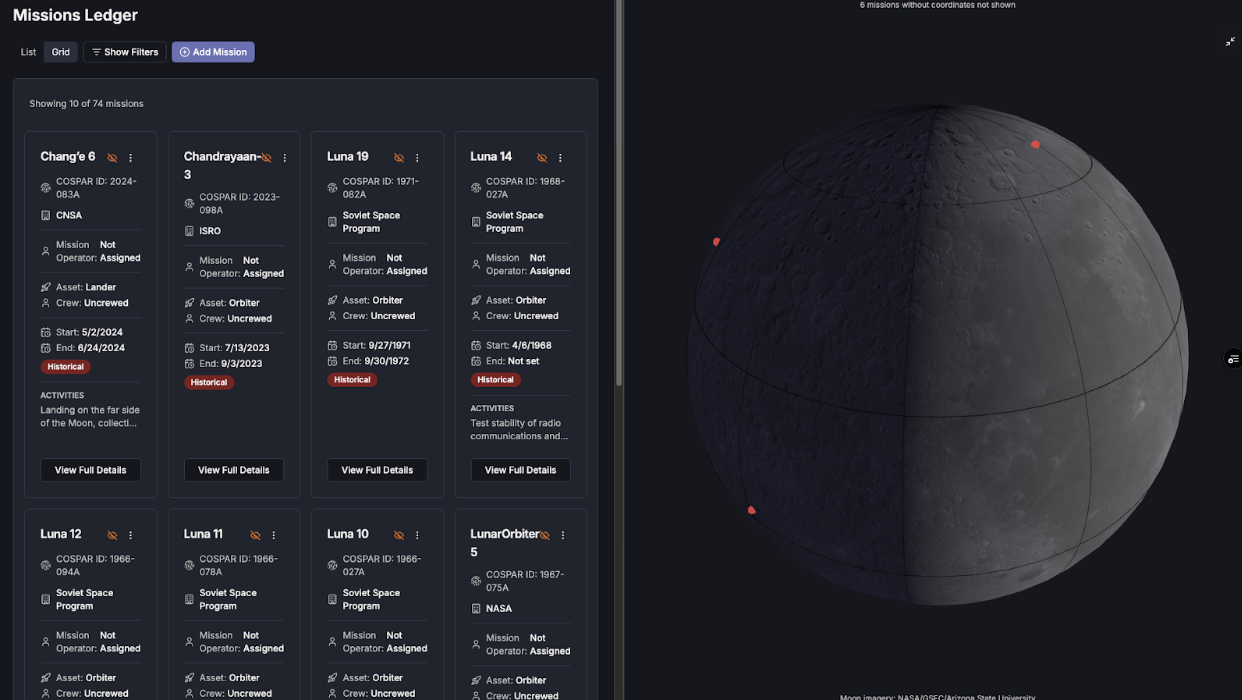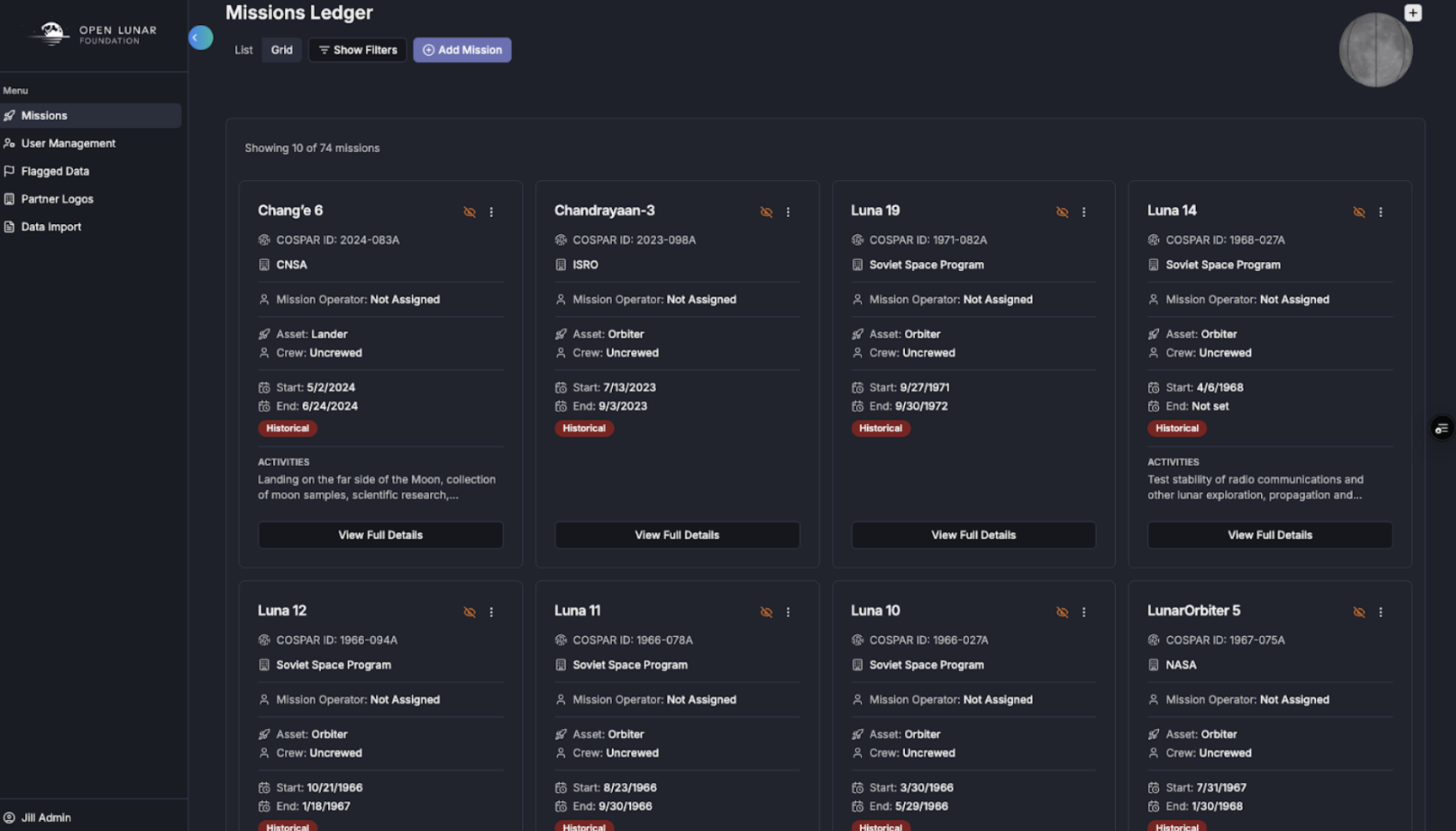Transparent by Design: The Lunar Ledger Beta and the Future of Lunar Collaboration
AUTHOR: CHRISTINE TIBALLI, OPEN LUNAR FELLOW AND LUNAR LEDGER LEAD
Screenshot Moon visualization tool
Here’s Where We Are with the Ledger
To keep pace with lunar development, the Lunar Ledger is now in closed beta with selected partners. Months of design and a concentrated build sprint have brought our core transparency and collaboration features to life, and we’re now refining them with direct user feedback. Below is a snapshot of the platform’s current status and what’s next.
Minimum Data Sharing Commitments: A Foundation for Transparency
The Ledger sets a clear baseline for openness by asking every participating mission to provide a defined set of essential information. This includes core fields like: location, objectives, responsible parties, and activity timelines. The intent is simple: establish trust and awareness while respecting operational boundaries. By standardising what’s shared, we create a landscape where cooperation is possible and risks are minimised, without demanding the exposure of sensitive or competitive data.
Secure Role-Based Permissions: Defining Access, Empowering Users
The Ledger’s role-based permission system is designed to give users control and clarity over their data. Mission operators can manage and update their records, while advisors and other roles have read-only or limited access based on clearly defined needs. By structuring access in this way, we protect the interests of commercial ventures and their IP, public agencies, and researchers alike. No one sees more than they should, and every participant knows exactly where they stand.
Granular Public/Private Data Controls: Transparency with Purpose
These commitments aren’t just policy; they’re directly reflected in how the platform works. Each data field in the schema is clearly marked as public or private, so mission operators know exactly what they’re sharing and with whom. The majority of details are public, maximising transparency, but we recognise that some information must remain confidential.
Looking forward, we’re preparing new user roles that allow selective data sharing: for instance, giving researchers access to commercial mission data that competitors won’t see, or opening select records for citizen science verification. This structure turns transparency into practice, ensuring that data flows to where it delivers the most value while respecting the realities of commercial, public, and research-driven space activities
Sample screenshot of historical Missions in Card View
Interactive Moon Map: Visualising Missions, Risks, and Cooperation
A standout feature of the Ledger is the interactive Moon map. Users can quickly see where missions have been, are happening, or are being planned across the lunar surface. With a glance, it’s possible to identify concentrations of activity, spot potential hazards, or find opportunities for shared infrastructure or payloads. The visual interface helps teams not only manage risk, but also think differently about location-based cooperation, all while staying grounded in real mission data.
Audit Logs: Ensuring Traceability and Trust
Every change made in the Ledger is tracked, creating a clear and permanent record of who did what and when. This audit trail is non-negotiable for accountability. It means that, no matter how the database grows or shifts over time, there is always a source of truth - one that supports shared confidence across the lunar community.
Beta Testing: Who’s Involved and What’s Next
The Ledger is currently in closed beta, with a group of users selected for their range of perspectives across the space ecosystem. Their feedback is shaping not just the details, but the overall feel and workflow of the platform as we refine it for broader release. As we move forward, we continue to welcome input from the community and look forward to sharing new milestones as the Ledger evolves.
Why it Matters
The practical features of the Ledger go beyond operational efficiency. As missions share data in a reliable and transparent manner, the platform can support informal oversight, collaborative problem-solving, and the emergence of shared standards within the lunar community. While this approach complements existing policy and governance frameworks, it also adds a crucial layer of mutual accountability and collective learning. In a landscape where regulations are still taking shape, open information sharing serves as a practical tool for building norms and trust, helping reinforce responsible conduct across all participants.
How your organisation can get involved:
Lead the way in responsible lunar operations. Join the Lunar Ledger to help set precedents for safe, transparent activity, and secure your stake in the Moon’s shared future.
Subscribe to Open Lunar’s newsletter for exclusive updates and the next steps to get your team on board.


